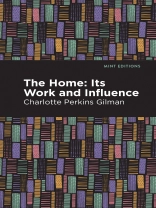The Home: Its Work and Influence (1903) is a sociological study by American author and feminist Charlotte Perkins Gilman. Inspired by her work as a social reformer and advocate for women’s suffrage, Gilman sought to write a work of nonfiction that explained the role of the home as a human institution, as well as to address the problems and inequities of home life—especially for women. In the beginning, Gilman argues that “[e]very human being should have a home.” The role of the home in human society, she claims, is not only to provide safety and comfort, but to facilitate the productivity, creativity, and individuality of every person. Despite this, the home has evolved far slower than all other human institutions, ensuring that the life of humanity has failed to progress as far as its ideals would suggest. Having identified this problem—as well as shown that women bear responsibility for maintaining households while men control the home as a system of power—Gilman moves through such topics as domesticity, cooking, entertainment, and children in order to properly identify the highly gendered roles of each member of the home. Ultimately, Gilman argues that a progressive home will benefit not only each individual within the family unit, but the whole of society at large. The Home: Its Work and Influence is a powerful work of sociological thought by a leading reformer and feminist of her day.
This edition of Charlotte Perkins Gilman’s The Home: Its Work and Influence is a classic of American literature and nonfiction reimagined for modern readers.
Since our inception in 2020, Mint Editions has kept sustainability and innovation at the forefront of our mission. Each and every Mint Edition title gets a fresh, professionally typeset manuscript and a dazzling new cover, all while maintaining the integrity of the original book.
With thousands of titles in our collection, we aim to spotlight diverse public domain works to help them find modern audiences. Mint Editions celebrates a breadth of literary works, curated from both canonical and overlooked classics from writers around the globe.
A propos de l’auteur
Charlotte Perkins Gilman (1860-1935) was an American author, feminist, and social reformer. Born in Hartford, Connecticut, Gilman was raised by her mother after her father abandoned his family to poverty. A single mother, Mary Perkins struggled to provide for her son and daughter, frequently enlisting the help of her estranged husband’s aunts, including Harriet Beecher Stowe, the author of Uncle Tom’s Cabin. These early experiences shaped Charlotte’s outlook on gender and society, inspiring numerous written works and a lifetime of activism. Gilman excelled in school as a youth and went on to study at the Rhode Island School of Design where, in 1879, she met a woman named Martha Luther. The two were involved romantically for the next few years until Luther married in 1881. Distraught, Gilman eventually married Charles Walter Stetson, a painter, in 1884, with whom she had one daughter. After Katharine’s birth, Gilman suffered an intense case of post-partum depression, an experience which inspired her landmark story “The Yellow Wallpaper” (1890). Gilman and Stetson divorced in 1894, after which Charlotte moved to California and became active in social reform. Gilman was a pioneer of the American feminist movement and an early advocate for women’s suffrage, divorce, and euthanasia. Her radical beliefs and controversial views on race—Gilman was known to support white supremacist ideologies—nearly consigned her work to history; at the time of her death none of her works remained in print. In the 1970s, however, the rise of second-wave feminism and its influence on literary scholarship revived her reputation, bringing her work back into publication.












